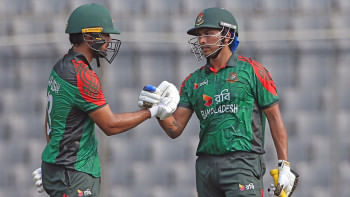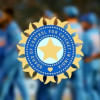Time to let Soumya be Soumya

You've probably seen that image: an elephant, a fish, and a monkey all told to climb a tree. It's often used to show how the education system unfairly judges everyone by the same test, leaving some to shine and others to feel inadequate. The image makes its point perfectly. But its lesson shouldn't stop at the classroom door.
In sport too, we often measure everyone by the same yardstick, overlooking the external factors that define how much impact a player truly makes.

The risks of this are many: a promising athlete could lose what makes him special by trying to meet the set standard; stat-padders could use it to stand out; and, most importantly, a sport could lose out on special talents: the unconventional geniuses who add so much charm to the sport.
Cricket's uneasy relationship with convention
Cricket, from its very beginning, has been guilty of rigidity. With time, the British pastime of the 1800s has developed into a dynamic sport, but it still remains a game closely tied to convention and finds it very hard to let go of it.
When the great Don Bradman first burst onto the scene, the British lords who ran the game were appalled, because rather than applying the textbook shot for a particular line and length, he improvised: moving a bit to the side to cut a bouncer rather than hooking it, or pulling a slightly short-pitched delivery rather than cutting it.
Those days are long gone. English batters are now regularly reverse-sweeping deliveries coming at them at 90 miles per hour in the first session of an Ashes Test. The game has moved on. But not everywhere: case in point, Bangladesh.
Even now, local coaches scold young boys if they dare to hit the ball on the up; bowlers are told to "fix" their natural actions; and batters are often judged by one thing alone: how many runs they score.
Of course, runs matter — just as water is essential to life — but focusing solely on numbers while ignoring how, when, and against whom those runs come is a shallow way to assess cricketing worth.
Soumya Sarkar: the natural rebel
The domestic structure only deepens the problem. Most players who make it to the national side bat in the top order for their clubs, because batting longer means scoring more, and more runs mean more recognition.
So, in a cricketing nation where anything unconventional is quickly discarded, it's remarkable how a player like Soumya Sarkar has managed to survive in international cricket till now.

From how Soumya shapes up at the crease to his fluent conventional stroke-making, there's so much to like about the elegant left-hander: when he gets going, he is arguably the most eye-soothing batter in Bangladesh.
His talent is obvious to anyone who knows anything about cricket, and that was the very reason he ended up playing in a World Cup in 2015 after having played just one ODI beforehand.
But while the management recognised his talent, and took into account the runs he scored in the domestic scene, they failed to judge who he exactly is as a batter.
To get the most out of a player, it's imperative to understand what he actually offers, borrowing and adapting a phrase from the world of business: what's his Unique Cricketing Point (UCP).
Soumya's UCP is his natural aggression. Unlike many batters, he doesn't stare down the approaching delivery with a grimace on his face before throwing the kitchen sink at it to try and up the ante: for him, throwing caution to the wind comes naturally.
His whirlwind style could cost him his wicket cheaply, but if he sticks around for long enough as an opener, more often than not he will provide positive momentum for the rest of the batters to carry forward.
These assumptions are backed by stats as well: Soumya's career strike rate in ODIs of 94.92 is the best for a Bangladeshi batter who has played at least 30 innings.
But Soumya's aggression is a double-edged sword: a batter whose UCP is aggression cannot be relied upon to score runs consistently, and logic dictates that his aggression must have hampered his average.
Even in that sense, Soumya is an exception.

Among all batters who have batted at least 50 times for Bangladesh in ODIs, Soumya's average of 33.40 is fifth-best, right behind the so-called big four of the country's cricket: Shakib Al Hasan (37.29), Tamim Iqbal (36.65), Mahmudullah (36.46), and Mushfiqur Rahim (36.42).
Simplistic stats can be deceptive at times and need to be put into context. However, in Soumya's case, the context only makes him stand out even more: unlike those four stalwarts, he has hardly had the chance to stat-pad against weaker sides; he has played only two ODIs against Zimbabwe in his whole career, and one of those games was his debut match.
By combining the runs he has scored and the brisk rate at which he has scored them, Soumya becomes, arguably, the most impactful batter Bangladesh have ever had in the format.
Even by global standards, Soumya's ODI stats are nothing to be scoffed at. Among the top-order batters with at least 74 innings in ODIs — same as Soumya, and who are active right now — only four have both a better average and strike rate: Jason Roy, Jonny Bairstow, Travis Head, and Quinton de Kock, who recently came out of retirement.
The numbers show Soumya to be a standout ODI batter for Bangladesh, who, at 32 years of age, should now be a mainstay in the side.
The burden of perception
So why did Soumya have to make yet another comeback in the recent West Indies series? The answer, as Bob Dylan once said, is blowin' in the wind.
It's not his failures that draw criticism, but the way he gets out. His minimal foot movement -- the same trait that enables his timing -- looks careless when a delivery sneaks through the gate; his lofted drives seem reckless when they fall short of the rope. His flair, when it fails, makes his dismissals appear unforgivable: as if he isn't trying hard enough.
The blazing start to his ODI career almost worked against him in the long run: Soumya averaged over 51 with a strike rate of 102.28 in 2015, which really raised the bar of expectations from him.
The weight of expectations proved to be too much, as the law of averages caught up with him, and in the years that followed, he looked like a player who had lost his way.
The management also added to his confusion: they tried him out in the lower order as a medium-pace bowling all-rounder during this period.
Even after playing under such uncertainty for years, Soumya managed to maintain his impressive strike rate while also preserving a steady average, which makes one wonder what he could've achieved had the management understood exactly what he offered as a player and groomed him accordingly.
Rediscovering the real Soumya
His latest return, against the West Indies, was proof of what self-belief can do. With 140 runs in three innings, including a sublime 91 off 86 balls on a spinning track, he reminded everyone what he offers when given the freedom to play his way.
At 32, Soumya still has quite a few years of cricket left in him: enough time to make more significant contributions for Bangladesh cricket.
Let's just hope that from now on, the system stops trying to mould Soumya into what it thinks he should be, and simply lets him be.

 For all latest news, follow The Daily Star's Google News channel.
For all latest news, follow The Daily Star's Google News channel. 









Comments